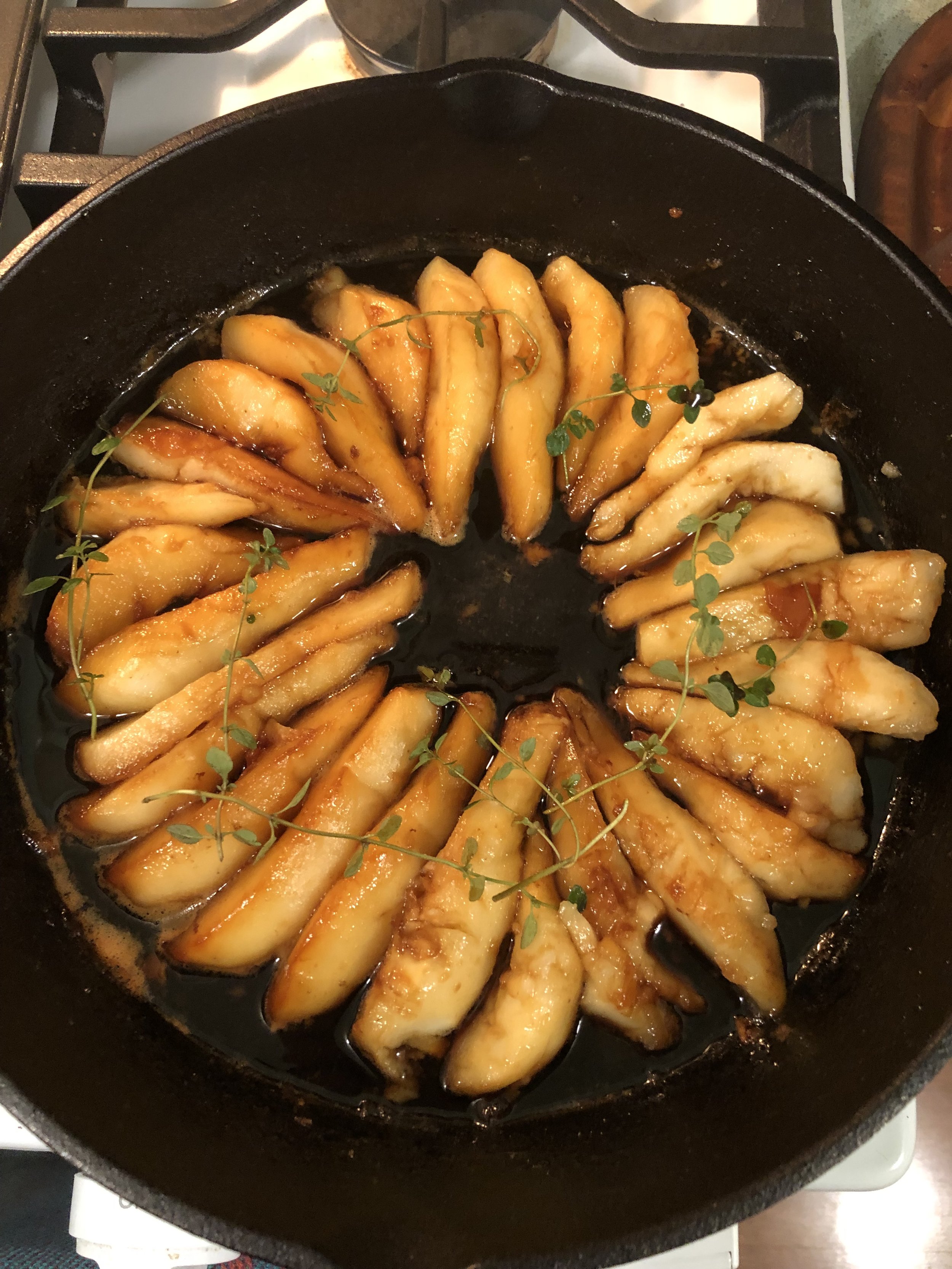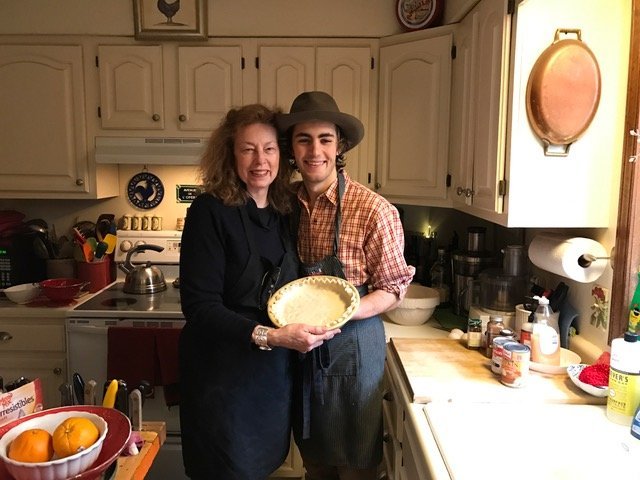Cooking with Autumn Fruit
This holiday season I’ve had the urge to try some new dishes along with some old family favorites. After being invited to dine with our wonderful neighbors Anita and Dolores, I decided to bake a pear with honey upside-down-cake for dessert. This is a gorgeous, honey-golden, irresistible autumn dessert that disappears without guilt and is a grand finisher at the end of a holiday meal.
The recipe calls for 3-4 Bosc pears—a wonderful old-world kind of pear that tastes like a cross between a pear and an apple. Skinned, cored, and sliced into quarters, the pears are arranged in a cast iron skillet where they simmer 8-10 minutes in ¼ cup honey (the more exotic the better). Then add a few sprigs of thyme and bake 25 minutes in a 350º oven while you assemble the cake ingredients—1 cup sugar whisked with the zest of a lemon, 1 tablespoon vanilla, 2 eggs, ½ cup melted butter, and 1 cup flour with a dash of salt. Pour the batter over the honey-simmered pears that have been brushed with ¼ cup melted butter, sprinkle with ¼ cup sliced almonds and bake an additional 25-30 minutes.
I love every stage of the preparation of this delicious dessert that culminates with a deft turn-of-the-wrist maneuver that releases the skillet cake onto a strategically positioned plate. The heavy 9” Lodge #7 cast iron skillet that I use requires lumberjack-strength wrists for this recipe with origins from the old Gramercy Tavern in Lower Manhattan. Our son Hayden informed me that “gramercy” in French means “merci” or thanks. If you haven’t chopped and split your own wood lately, three hands and a bit of “god have mercy” faith are needed for this pear cake’s flip and release finale. But I can promise you, the rustic golden cake topped with a honey-hued swirl of simmered pear slices will be worth the effort.
Winter pears allowed to ripen slowly before glazing in brandy also make a delectable marmalade when cooked with lemons and ginger. It is also the perfect time to cook up the oft overlooked persimmon. My history with persimmons was initially Asian, related to travels in China and Japan. While in Beijing several decades ago, Kit and I came upon a dwarf persimmon tree in a large porcelain planter, gracing a small interior courtyard within the Forbidden City’s maze of more than a thousand rooms. Lacquer-red persimmons hung like Chinese lanterns from the tree’s bare branches, as exotic as the land where this ancient fruit has grown for centuries.
Persimmons found in local markets are the Fuyu Japanese variety. Plump and very firm, they look much like a shiny orange tomato with a dogwood-shaped dark green collar at the stem. Caucasian common persimmons are smaller and rarely picked before they ripen after a late autumn frost has dulled their natural shine and they fall from the tree. If eaten before they look almost spoiled, persimmons can cause the mouth to pucker.
I first encountered wild persimmons while living in Missouri. In November, I’d gather fallen persimmons from the base of our tree at Boomerang Creek. When I had enough for the pulp I needed, I’d get out my mill (chinois) and Beech wood pestle (pilon) for separating the pulp from the fruit’s seeds and skin. Two hours later, I’d end up with about six cups of sweet persimmon pulp that was then baked into an exquisite flan-like pudding.
Persimmon pudding is a nearly forgotten Thanksgiving treasure worth rediscovering. Variations on persimmon pudding recipes reveal much about this fruit native to America along with a part of this country’s culinary history. I use the recipe in my old Joy of Cooking cookbook—my dear friend Marjo Price’s favorite. Serve it warm or cold with ice cream or whipped cream. Martha Stewart recommends adding a generous touch of brandy as well, just like George and Martha Washington did at Mount Vernon. Amen to that! For the recipe, search “Marjo Price’s Plated Persimmon Pudding” under desserts at www.thecommoningredient.com.
Over the prior week I’ve been perusing pie recipes in past Thanksgiving issues of my favorite cooking magazines, family recipes and others that I’ve clipped and saved over the years. The best, I’ve concluded, is the hard-to-beat pumpkin pie recipe my mother Alice made every Thanksgiving for my father and her four grateful daughters. Mother used Libby’s pumpkin pie recipe found on cans of their pumpkin puree. It’s a recipe I shared with our grandson Nico when he visited Kit and me at Boomerang Creek a decade ago and wanted to learn how to crimp the edges of a pie crust. Yesterday, I made one for a vegetarian Thanksgiving gathering our daughter Heidi and her wife Sugie hosted at their home here in Nevada City. For the recipe, search “Libby’s Pumpkin Pie” under desserts at www.thecommoningredient.com
This morning I baked a pecan pie for a day-after-Thanksgiving gathering being hosted by Tim and Terri—local friends who are preparing a traditional Thanksgiving turkey meal with dressing and mashed potatoes. Guests are bringing assorted sides, hors d’oeuvres and desserts. What a joy it is to live in a small, inclusive neighborhood in the Sierra Foothills with friends who share communal provender, a sense of harmony, meaningful conversation and a love of football. These are blessings for which I give thanks this holiday season.






